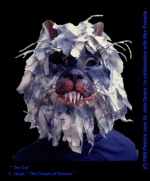
" The
Cat "
© 1989
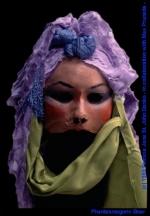
" The
Woman "
© 1989
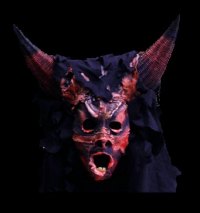
" The Devil "
© 1989
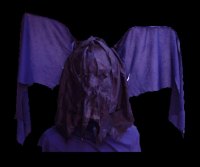
" The
Phantom "
© 1989
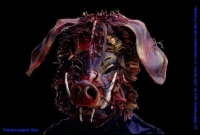
" The
Boar "
© 1989 |
The title of
this play by Antonio Buero-Vallejo, one of Spain's most significent 20th
century playwrights, is taken from one of the best-known etchings of the
18th century Spanish artist, Francisco de Goya, called "The Dream of Reason
Produces Monsters." After the first production of this play in Madrid in
1970, its translation into other languages established the international
reputation of the writer, who had turned to theatre after six years of
imprisonment for support of the Republican cause during the Spanish Civil
War.
The play is set
in 1823, when the deaf and aging Goya has covered the walls of his country
retreat with his "Black Paintings," and is living under the threat of physical
abuse and even death from the repressive forces of the autocratic Ferdinand
VII.
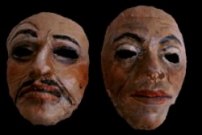
"
Soldiers "
© 1989
Buero's play
explodes traditional dramatic conventions because it merges and confuses
visual and aural, verbal and nonverbal elements to a degree where painting,
music, movement, masks, and scenography create a "total theatre" in which
it becomes difficult to separate vision from reality, dream from madness,
or fear from desire.
This production,
translated into English by Marion Peter Holt, was directed by Tere Quintanilla,
and produced by No Encontramos, Diverse Works, and Chocolate Bayou Theater,
with a support from the Cultural Arts Council of Houston, the Southwestern
Bell Foundation, and the Consulate General of Spain. Sets were designed by
Greg Roach, music composed by Jeff Darling, and dramaturgy by Johannes Birringer.
The terrifying masks were designed and created by Patricia Jane St. John-Danko
and Max Pruñeda.
Excerpted from the Playbill and
from William Albright,
" Dark, silent genius of Goya makes for unsettling theather ",
The Houston Post, February 21, 1989.
All
masks
designed and constructed
of mixed media, in collaboration by
P. J. St. John Danko
and
Max Pruñeda.
|







